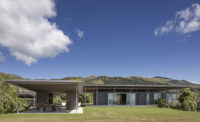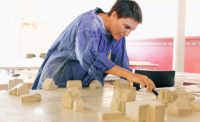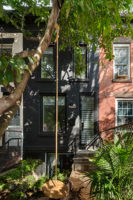With a very modest budget and a narrow, elongated site in the tiny village of Gaüses, the clients asked for a small house that could be used as a painting studio as well as an occasional weekend home for their children.
Design concept and solution:To make the project economically viable, the architects needed to work with local materials and craftspeople, and come up with a design that would be compatible with traditional construction techniques in the region, such as the use of load bearing walls, single-direction forgings, aluminium windows of reasonable dimensions, and conventional finishes. On this basis, the 1,000-square-foot house is divided into two well-differentiated sectors: the heart of the house—an open-plan space with living, dining, and kitchen areas; and a more intimate space with two bedrooms and a small bathroom.
Local building codes mandated a sloping roof, incorporated into this house to recall the profile of the mountains on the horizon. This roof continues from the main structure to the river-cane-covered porch that serves as an entrance to the house and provides shade for the northwestern and southestern facades. The porch is constructed of a lightweight metallic structure formed by square tubes, T- and L-profiles according to position. River cane is quite inexpensive but has a limited lifespan. Due to a simple installation—the cane is tied onto the structure with tensioned cables and flanges—the owner can replace it approximately every two years. The roof is designed to help ventilate the house naturally. Referred to as a double roof, it features an air chamber of about 1 foot. Through perforations in the building’s facade, air enters the chamber through the lowest part of the roof, exiting through the highest. The roof’s slant allows rainwater to collect at its center, draining into a ground-level water tank, which irrigates the kitchen garden.
The two facades of the dwelling below the cane canopy are painted in vertical white and green stripes, allowing the shadow from the cane to produce a play of textures that changes with solar orientation during the day. This design is also a response to the type of facade finish the budget imposed. The mortar render on the ceramic brick wall cracks easily. By superimposing a highly contrasted pattern, in this case a white and green bar code, the cracks become blurred behind the main pattern.
One notable feature of the dwelling is an opening in the living room’s corner with a system of lacquered aluminium sliding doors that, when open, gives the sensation of the room extending onto the porch and into the garden, and provides splendid vistas over the village of Gaüses and the mountains beyond.
Total construction cost:
70,000 euro
PeopleArchitect: Anna & Eugeni Bach, Architects
Architect of record: Anna & Eugeni Bach
Consultant(s): Quantity Surveyor:
General contractor: Jordi Marcó
Photographer: Jordi Bernadó Palo AltoPellaires 30-38, Edifici A1,1 E08019 Barcelona T +34 93 303 31 48 F +34 93 303 01 84 |
ProductsWindows Aluminum: Doors Wood doors: Interior finishes Acoustical ceilings: Paints and stains: Plumbing Josep Ventalló |






















Post a comment to this article
Report Abusive Comment